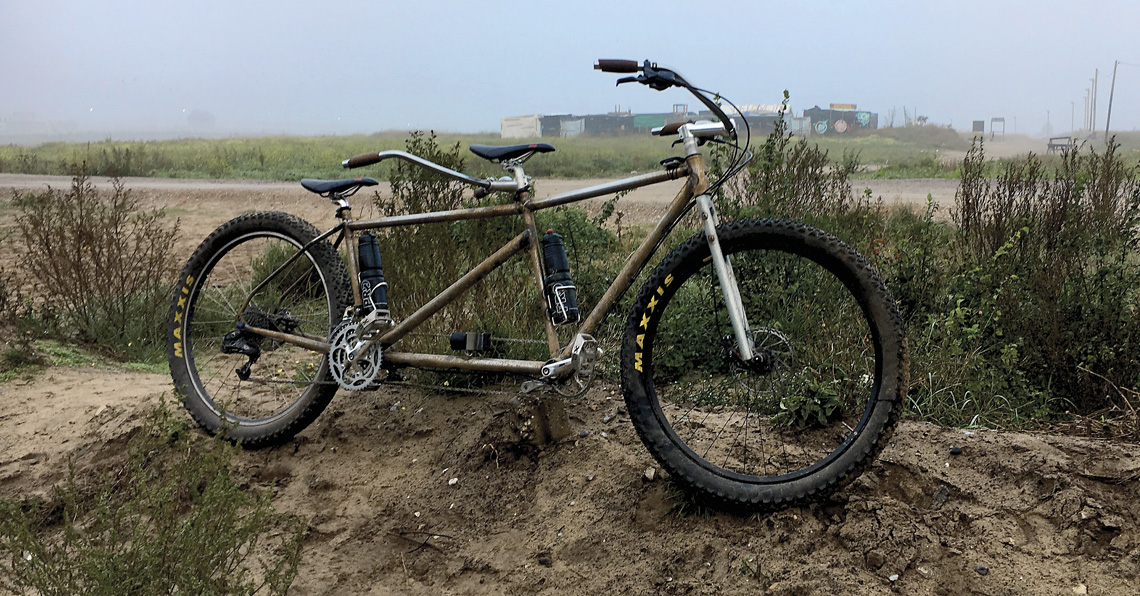Learning about the European borderscape on a tandem bicycle
Issue:
XXVIII.2 March - April 2021
Page: 16
Digital Citation
Authors:
Liam Healy

In 2016, my colleague Jimmy Loizeau and I designed a tandem bicycle to take to Northern France to conduct research on migration in the "Jungle Camp," a refugee and migrant camp that existed near Calais from January 2015 to October 2016. The bicycle was equipped with various recording devices (microphones and cameras) mounted to bright pink attachments, so that the bicycle would become a kind of roving, data-gathering, participatory interview machine. In this photo essay, I show how the tandem was made, what it did, and some of the things that it revealed in the camp.
 |
This is a shop drawing used for making the tandem. These were printed to a large scale for use in the workshop. The bicycle frame was custom made to fit large, "semi-fat" bike tires that would be suitable for the mix of terrain (mud, sand, gravel) at the camp. |
 |
The tandem was deployed several times, including on the night before the camp was cleared by French authorities toward the end of 2016. This collage is made up of images taken on this final night. The bike is in the center of the collage surrounded by several other events, for example a group of photographers putting on gas masks to get nearer to a disturbance, as well as three men transporting their things in a shopping cart. Original photos by Clare Thompson. |
 |
The tandem frame in its jig during manufacture. The jig was constructed from a combination of off-the-shelf aluminum extrusion combined with custom-machined parts to hold the various frame components in place during welding. |
 |
The bike and its documentation equipment were tested in London before being deployed, helpfully documented here by a Google Streetview car. |
Several other bikes are on a long stretch of road, the Rue de Garennes. Clare and I are in the car following the tandem. An informal, organic race materialises. The glitzy tandem is seen as a challenge [and it] is fast, leaving the riders on the largely donated bikes behind.— FIELD NOTES, OCTOBER 2016
 |
Often the bicycle was passed around and ridden by several different people who lived and volunteered in the camp to use as they wished. Sometimes I would accompany them, sitting either on the back as a stoker or piloting the bike from the front [see field notes, opposite page). |
 |
The bicycle was not always successful in its intended use. For example, in this image I am attempting to conduct an interview on the bike with "Sami," who lived in the camp. The interview was very hard to conduct, and the resultant recording was mostly muffled by the wind noise generated by us speeding back toward Sami's shelter, having collected supplies to make tea. |
 |
Though the tandem did not work as we had intended, it was quite adept at inviting new uses in the empirical sites, for example (and somewhat predictably), racing (see field notes).
Though speed was a problem in the ways in which the bike functioned as an "interview machine," it arguably conducts research in another way—as researchers, we are perhaps being told (at speed), "No, we are not interested in answering your boring questions; we want to have a race instead!" |
 |
While Sami and I were riding through one of the camp's checkpoints, we were stopped by the CRS riot police who monitored the camp. One policeman eyed the bicycle and, talking in French, waved over his colleague sitting in a nearby police van. After shooing us off the bike, they both grabbed the handlebars, got on, and cycled off.
Stills taken from the short film A/symmetries of Tandeming. |
Sitting on the back of the bike, as a stoker, you are driven, with no power to control the speed, destination, or route. It's an uncanny feeling—strange enough with people you know well—and requires placing utmost trust in the pilot despite never having met them before.— FIELD NOTES, OCTOBER 2016
 |
Bicycles were quite commonplace in the camp. These are bicycles that K and Sami shared, assembled from donated bikes that were brought in by several charities. |
 |
An extended ride through the camp revealed many other aspects of the space, such as the importance and prevalence of play. |
 |
After the Camp was cleared, I made a number of trips back to Calais, including in 2019 when I retraced a route through the old camp that I had recorded in 2016. After the camp was cleared, the site was turned into an "eco-park." I found that the "re-wilding" that was taking place on the site exposed the kinds of life that are permitted in a Europe becoming increasingly hostile toward displaced people.
Stills taken from the short films Calais Then (2016) and Then (2019). |
 Author
Author
Liam Healy is a designer, researcher, and lecturer working across a wide range of disciplines and media. He recently completed his Ph.D. by practice at Goldsmiths, University of London, which aimed to develop and analyze situated "a-firmative" speculative practices that engage with the European borderscape. [email protected]

Copyright held by author
The Digital Library is published by the Association for Computing Machinery. Copyright © 2021 ACM, Inc.













